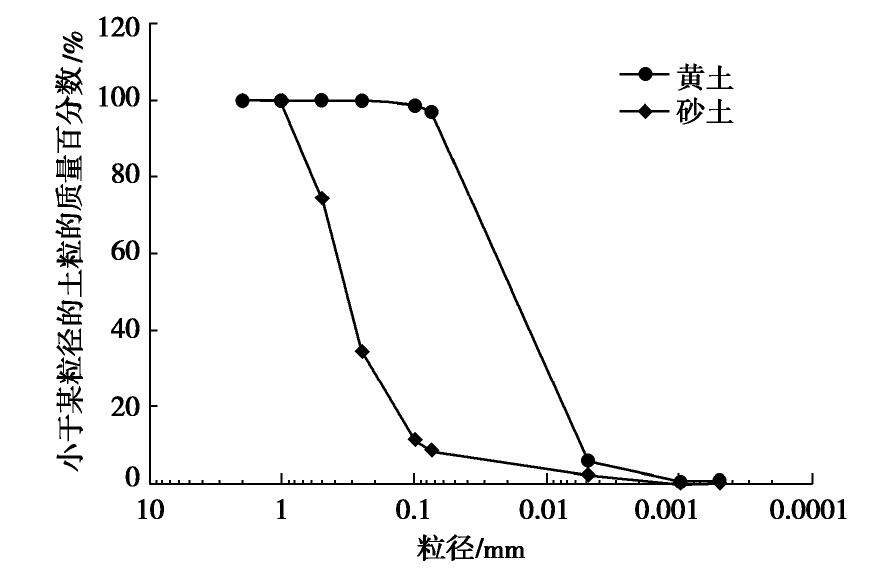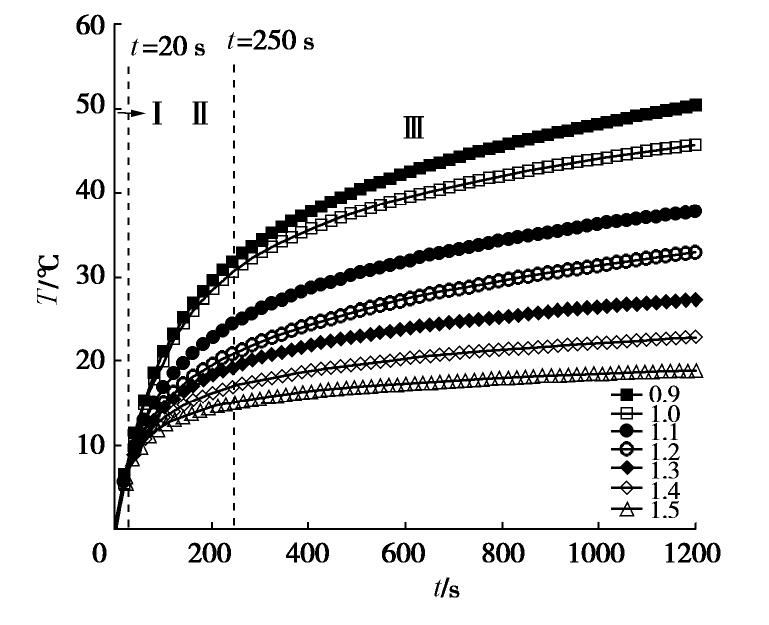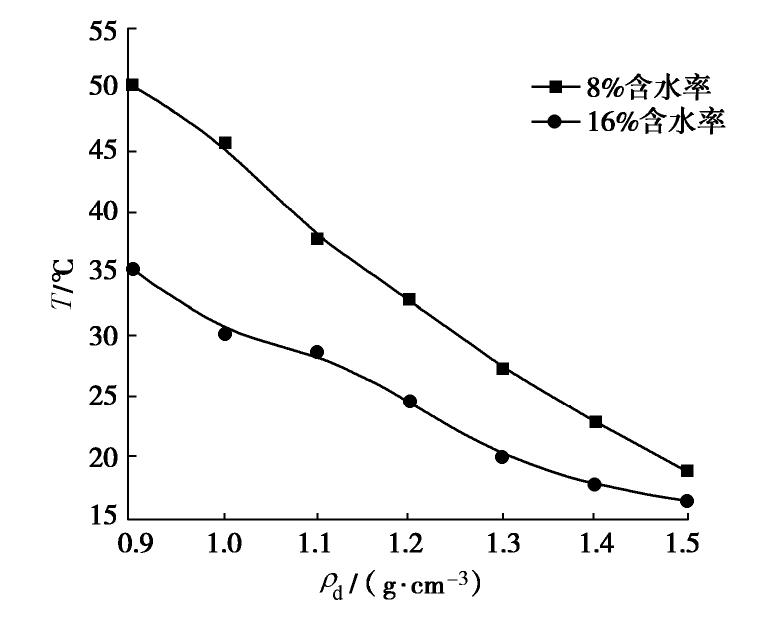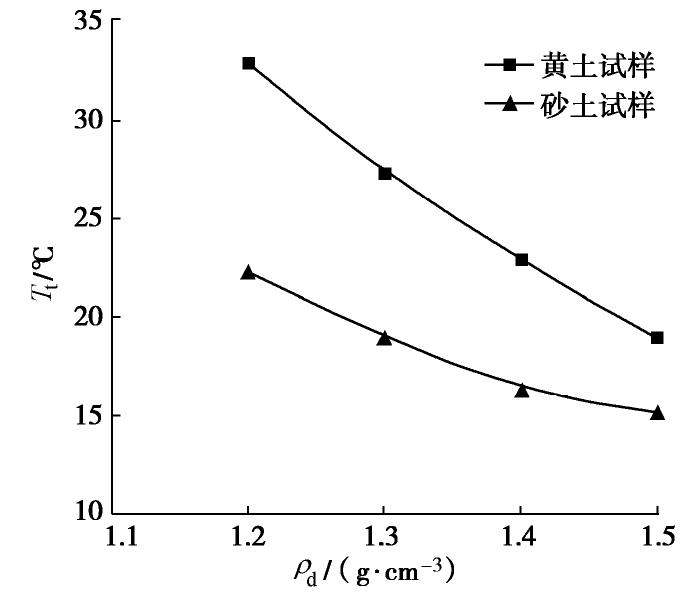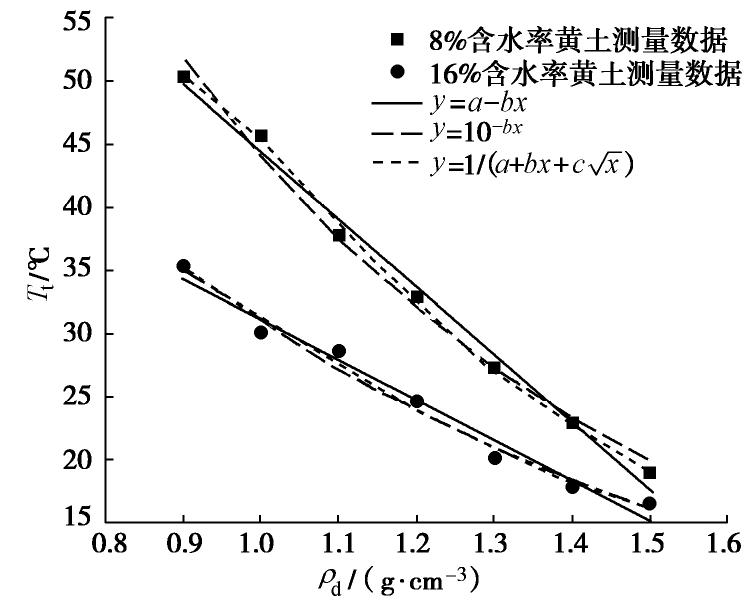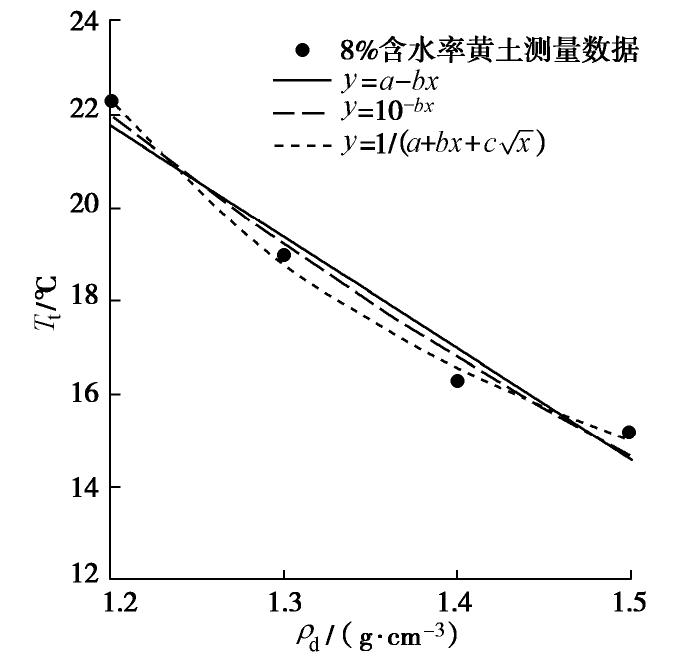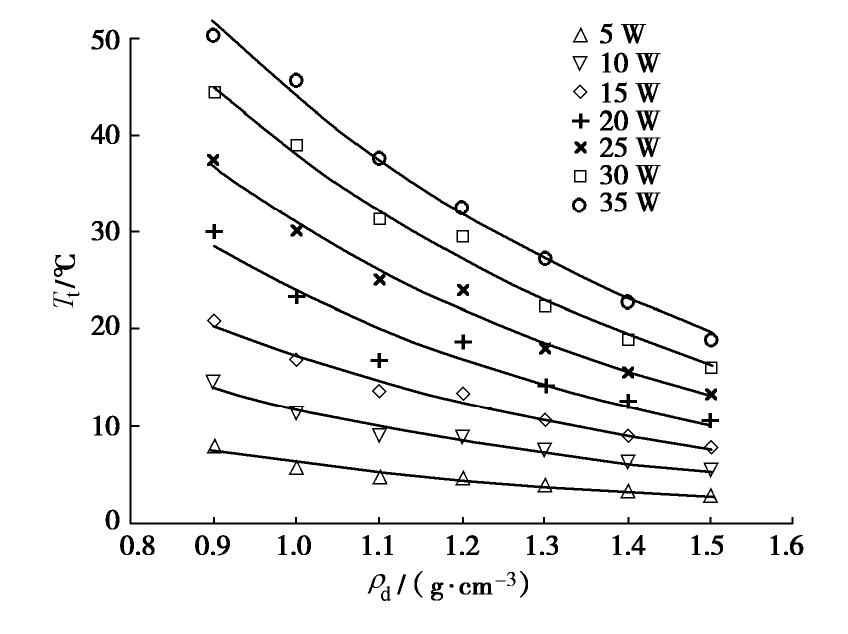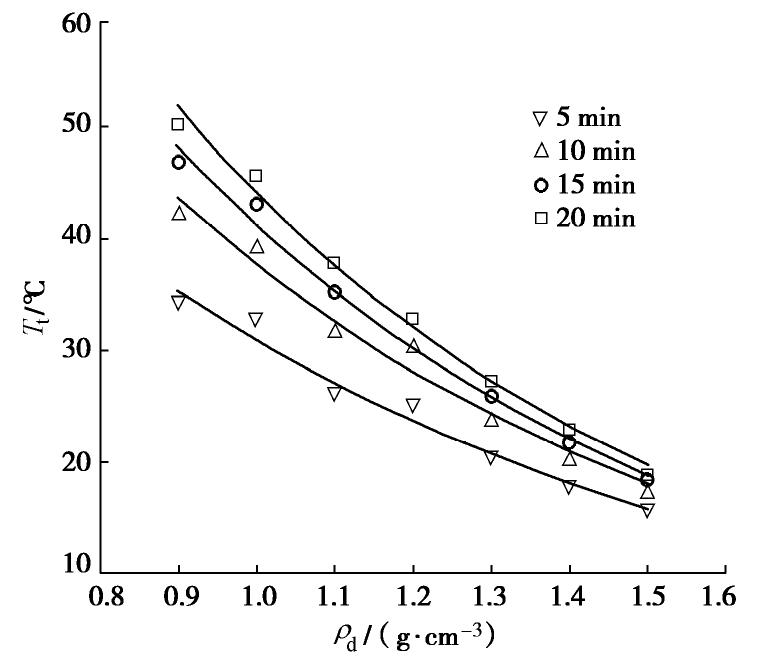Feasibility study on actively heated FBG methods for dry density measurement
-
摘要: 针对现有干密度原位测量技术的局限性,提出了一种基于主动加热型FBG的土体干密度原位测量方法(简称H-FBG干密度法),该法通过土体的导热系数,建立温度特征值(Tt)与干密度ρd之间的关系,进而对干密度进行原位测量;在室内试验的基础上,讨论了该方法的最优加热参数,研究了土类型与含水率对测量结果的影响,证明了该方法的可行性。试验结果表明:Tt随着ρd增加而降低,指数函数模型相较于幂函数模型和线性模型的Tt - ρd曲线拟合效果要好;H-FBG干密度法最优加热参数为15 W/m和5 min;高含水率土体受微观结构的影响,随着ρd增加Tt变化率减小。Abstract: An in-situ method based on the actively heated fiber Bragg grating for monitoring dry density is proposed (abbreviated to H-FBG) to make a progress in the existing technique. The relationship between the temperature characteristic value (Tt) and the dry density (ρd) is established through the thermal conductivity for the in-situ monitoring of the dry density. A series of indoor tests are carried to verify the feasibility of the method, the effects of moisture content and types of soils are discussed, and the heating parameters are determined. The results show that Tt decreases with the increasing ρd, and it is described well using the exponential function. 15 W/m and 5 min can be the best heating parameters applied for the measurement. The temperature of the soils with a higher water content decreases slowly owing to the effects of micro-structure of soils. The results may provide the theoretical and technical foundation for the further application of the proposed method.
-
-
表 1 土样的基本物理参数
Table 1 Basic physical parameters of test soils
初始含水率w/% 塑限wp/% 液限wL/% 塑性指数Ip 4.2 17 27 10 表 2 不同函数模型相关系数平方与均方根误差
Table 2 Fitting parameters of function models
土类 含水率 函数模型 表达式 a b c R2 RMSE/(g·cm-3) σ/% 黄土 8% 指数函数 Tt=10a−bρd 2.31 0.67 — 0.989 0.021 1.4 幂函数 Tt=1a+bρd+c√ρd 0.33 0.37 -0.68 0.993 0.047 3.4 线性函数 Tt=a−bρd 98.11 53.68 — 0.989 0.018 1.4 16% 指数函数 Tt=10a−bρd 2.04 0.55 — 0.980 0.027 1.9 幂函数 Tt=1a+bρd+c√ρd 0.15 0.20 -0.32 0.978 0.055 4.3 线性函数 Tt=a−bρd 59.80 28.99 — 0.953 0.041 3.1 砂土 8% 指数函数 Tt=10a−bρd 2.00 0.55 — 0.975 0.008 1.2 幂函数 Tt=1a+bρd+c√ρd -0.27 -0.09 0.39 0.992 0.030 4.7 线性函数 Tt=a−bρd 47.23 21.41 — 0.945 0.013 1.8 表 3 不同加热功率下的Tt-ρd曲线拟合参数
Table 3 Fitting parameters of Tt-ρd under different heating powers
功率/(W·m-1) a b R2 RMSE/(g·cm-3) σ/% 5 1.48 0.69 0.933 0.021 3.1 10 1.73 0.66 0.956 0.027 2.2 15 1.90 0.67 0.975 0.028 1.7 20 2.09 0.71 0.928 0.050 3.1 25 2.19 0.70 0.976 0.026 2.2 30 2.28 0.70 0.985 0.032 1.9 35 2.31 0.67 0.989 0.039 1.4 表 4 不同加热时间下的Tt-ρd曲线拟合参数
Table 4 Fitting parameters of Tt-ρd under different heating time
时间/min a b R2 RMSE/(g·cm-3) σ/% 5 2.04 0.55 0.972 0.024 1.7 10 2.19 0.61 0.975 0.025 1.8 15 2.27 0.65 0.988 0.026 1.7 20 2.31 0.67 0.989 0.025 1.6 -
[1] 高登辉, 陈正汉, 郭楠, 等. 干密度和基质吸力对重塑非饱和黄土变形与强度特性的影响[J]. 岩石力学与工程学报, 2017, 36(3): 736-744. GAO Deng-hui, CHEN Zheng-han, GUO Nan, et al. The influence of dry density and matrix suction on deformation and strength characteristics of the remolded unsaturated loess[J]. Chinese Journal of Rock Mechanics and Engineering, 2017, 36(3): 736-744. (in Chinese)
[2] SAKAKI T, KHLER S, HERTRICH M, et al. FE/LUCOEX: Density measurement of granulated bentonite mixture in a full scale mockup test using dielectric tools[C]//LUCOEX Conference and Workshop: Full-scale Demonstration Tests in Technology Development of Repositories for Disposal of Radioactive Waste, 2015, Skarshamn.
[3] SAKAKI T, FIRAT L B, VOGT T, et al. Heated fiber-optic cables for distributed dry density measurements of granulated bentonite mixtures: feasibility experiments[J]. Geomechanics for Energy and the Environment, 2019, 17: 57-65.
[4] 施斌, 张丹, 朱鸿鹄. 地质与岩土工程分布式光纤监测技术[M]. 北京: 科学出版社, 2019. SHI Bin, ZHANG Dan, ZHU Hong-hu. Distributed Fiber Optic Sensing for Geoengineering Monitoring[M]. Beijing: Science Press, 2019. (in Chinese)
[5] CAO D F, SHI B, ZHU H H, et al. A soil moisture estimation method using actively heated fiber Bragg grating sensors[J]. Engineering Geology, 2018, 242: 142-149.
[6] WEISS J D. Using fiber optics to detect moisture intrusion into a landfill cap consisting of a vegetative soil barrier[J]. Air Repair, 2003, 53(9): 1130-1148.
[7] DONG Y, MCCARTNEY J S, LU N. Critical review of thermal conductivity models for unsaturated soils[J]. Geotechnical & Geological Engineering, 2014, 33(2): 207-221.
[8] SINGH D, DEVID K. Generalized relationships for estimating soil thermal resistivity[J]. Experimental Thermal & Fluid ence, 2000, 22: 133-143.
[9] KERSTEN M S. The thermal conductivity of soils[J]. Highway Research Board, 1949, 28: 391-409.
[10] CHUNG S O, HORTON R. Soil heat and water flow with a partial surface mulch[J]. Water Resources Research, 1987, 23(12): 2175-2186.
[11] 许模, 王迪, 蒋良文, 等. 岩土体导热系数研究进展[J]. 地球科学与环境学报, 2011, 33(4): 421-427, 433. XU Mo, WANG Di, JIANG Liang-wen, et al. Review on thermal conductivity coefficient of rock and soil mass[J]. Journal of Earth Science and Environment, 2011, 33(4): 421-427, 433. (in Chinese)
[12] 谈云志, 喻波, 胡新江, 等. 非饱和土热导率预估模型研究[J]. 岩土工程学报, 2013, 35(增刊1): 129-133. TAN Yun-zhi, YU Bo, HU Xin-jiang, LIU Xiao-ling. Study of thermal conductivity for unsaturated unfrozen and frozen soils[J]. Chinese Journal of Geotechnical Engineering, 2013, 35(S1): 129-133. (in Chinese)
[13] 王铁行, 刘自成, 卢靖. 黄土导热系数和比热容的实验研究[J]. 岩土力学, 2007(4): 655-658. WANG Tie-xing, LIU Zi-cheng, LU Jing. Experimental study on the coefficient of thermal conductivity and specific volume heat of loess[J]. Rock and Soil Mechanics, 2007(4): 655-658. (in Chinese)
[14] 甄作林, 朱江鸿, 张虎元, 等. 砂土导热性能测试与预测研究[J]. 地下空间与工程学报, 2018, 14(6): 1577-1586. ZHEN Zuo-lin, ZHU Jiang-hong, ZHANG Hu-yuan, et al. Study on the measurement and prediction of thermal properties for sand[J]. Chinese Journal of Underground Space and Engineering, 2018, 14(6): 1577-1586. (in Chinese)




 下载:
下载:

